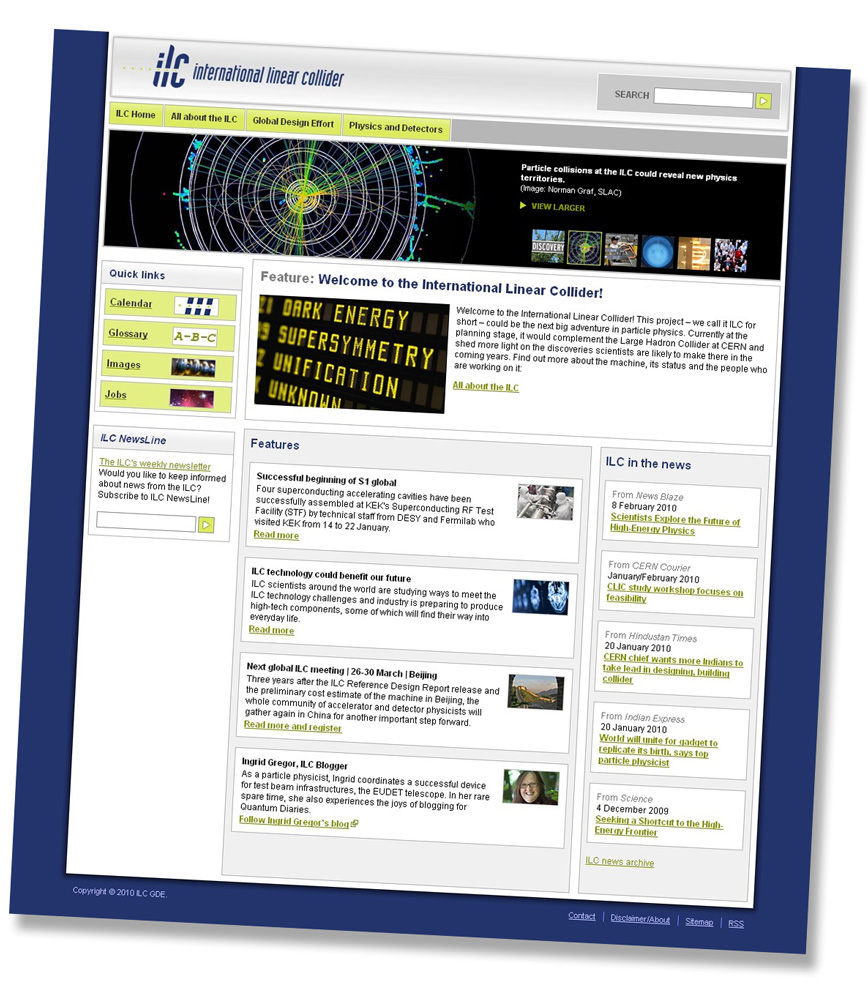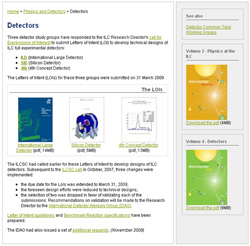Director's Corner
18 February 2010
 Barry Barish |
Change has come to linearcollider.org: take a tour of the renewed ILC website
Today's column is jointly authored by Maura Barone, manager of the project and collaborative tools for the ILC, and Barry Barish, GDE Director
Welcome to the new linearcollider.org! Ever since its inception, the goals of the ILC website have been to "provide one-stop shopping" for information about the ILC project and to do the crucial bridging of the great geographical distances separating those of us who are developing the ILC design. This is behind the continual demand for us to have an informative and a functional website, as well as one that is attractive and easy to use. Keeping this strategic vision in mind, we embarked on an ambitious project to improve our website by modernising the existing design, updating the content and upgrading the technology at the same time. We are proud to present the result that you see today as the new www.linearcollider.org website.
 Maura Barone, Maura Barone,manager of the project and collaborative tools for the ILC |
In the redesign process, we retained some of the same feel of the previous design and features that have been preferred by our readers. We made the site look more modern and clean by adopting a more vibrant color scheme, a wider page layout and a more flexible navigation. The web design itself was done by Xeno Media, a Chicago-based web agency that designed all the previous versions of our website. The carefully redesigned homepage displays a gallery of ILC images and features top stories and news clippings from around the world, providing continuous updates on progress on the ILC project or highlighting background stories and ILC-relevant topics.
Kevin Munday of Xeno Media has been a member of the ILC web strategic team for the last five years, and he likes to say: “websites are always changing because their use is always changing”. Based on the feedback from our readers and on our internal evaluations, we decided to totally restructure the website. The content has been broken down into high-level sections, accessible from the primary top navigation bar. Each of these sections conveniently displays a table of content and provides a separate layer of navigation. Anyone interested in finding general and timely information about the ILC and the people who are working on it, or in searching material to download or order in print, should not miss the revamped 'All about the ILC' area. The more technical sections, called 'Global Design Effort' and 'Physics and Detectors' are meant to give insights on and provide relevant tools for the day-to-day activities of the widely dispersed ILC collaboration. The pages in these two more specialised areas include contact information, meetings of the day, project reports, updates and much more.
To get you as quickly as possible to some of the most visited pages –'Calendar', 'Glossary', 'Images' and 'Jobs'–, we added a new 'Quick links' box to each and every page. We also added a convenient one-stop page for everything regarding ILC NewsLine. A complete overview of the new layout is offered by the website sitemap.
We added new technical features that will contribute to a more efficient navigation experience. To name one as an example, the system is now serving out easy-to-read and easy-to-remember web page addresses (URLs) — by far the most requested feature. There are also more RSS channels to subscribe to, and semantics have been added to the 'Calendar' and 'Contact' pages by adopting microformats.
Renewing the ILC website has been a collaborative and an international effort. We want to explicitly thank those who have made this project a reality.
First and foremost, the ILC Communicators, Jim Brau and Kevin Munday, who together with us have set out the goals and scope for this project. The ILC Communicators also contributed the information provided for the general public, as well as numerous suggestions varying from the style to look and content of the homepage. Likewise, Jim Brau well represented the 'Physics and Detector' community in writing and organising the content of that section.
Our thanks for the accurate design and customized upgrade of the system go to Xeno Media, in particular Mike Acklin and Alex Tarasiewicz. Thanks also to Tilted Planet for the flawless hosting of our web servers.
Particular thanks are due to some ILC-GDE members. David Seigle, a super summer student in computer science and then an 'on-call' contractor developed many additions and refinements. Kevin Flannery, our newest computer engineer and GDE web applications developer joined at a late stage, but still made some studies on the performances and contributed to the final roll-out.
We must admit that we had a truly monumental challenge resolving all the differences between the many strong minded people with conflicting opinions concerning aspects of the final site design. In this regard, we want to thanks the small committee made up of widely respected GDE members, who had no vested interests in our website. This committee consisted of Peter Garbincius, who served as a very able chair, Hitoshi Yamamoto and Brian Foster giving us global representation. They interviewed many of the principles, tested the website themselves, and then made a series of recommendations, and gave other suggestions that will help us map out continual improvements in the future.
Finally, the GDE Executive Committee members, as usual, made the effort to give useful comments, especially Marc Ross and Mike Harrison.
Overall, we feel quite excited about the result and hope you enjoy our new website. Let us know what you think about it.
-- Maura Barone and Barry Barish



 “All about the ILC” pages provide information on the ILC, including the most important one: “Why do we need the ILC?”
“All about the ILC” pages provide information on the ILC, including the most important one: “Why do we need the ILC?”